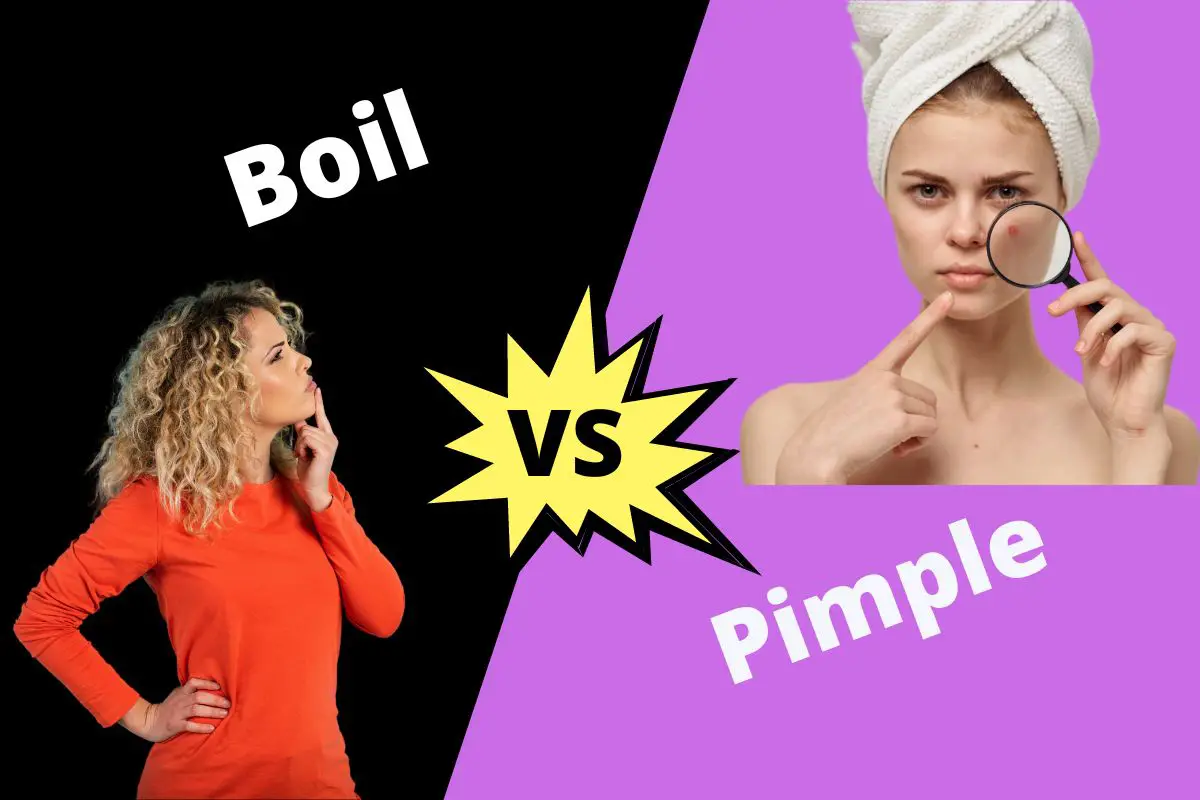The main difference between a boil and pimple is that a boil is a bacterial infection that forms a lump and fills with pus. A pimple results from a clogged pore.
Table of Contents
Boil vs Pimple
| Boil | vs | Pimple |
| Large, Keeps growing | Size | Small |
| Furuncle | Also Called | Pustule |
| Staphylococcus aureus | Bacteria Responsible | Propionibacterium acnes |
| Always infected, Can form carbuncles | Risk Factors | Not always infected, Can’t form carbuncles |
| Not called acne | Outbreak | Called acne |
| Can’t be treated with salicylic acid, needs to be excised and drained | Treatment | Can be treated with salicylic acid, it doesn’t need to be excised and drained. |
| Not caused by hormonal changes | Causes | Often caused by hormonal changes |
What is a Pimple?
Pimples, also called pustules, are a form of acne that pops up on your skin when the pores that form the opening to hair follicles clog due to excess oils.
The underlying cause for pimples may also be dead skin cells that form a plug trapping dirt or the Propionibacterium acnes bacteria inside.
Pimples commonly occur on the face or may appear on the upper back, shoulders, and chest. They typically don’t grow much in size, becoming a whitehead, blackhead, or papule within a few days.
Can You Pop a Pimple?
Although while taking the necessary precautions, some noninflamed whiteheads and blackheads pimples can be popped, dermatology advises against it. Popping a pimple may end up scarring and causing infection.
Home Treatment for Pimples
While skincare routines can help reduce their occurrence, a pimple may take up to 3 weeks to completely heal.
The following skincare routine may be followed to reduce the incidence of pimples:
- Gently wash your face using warm water and over-the-counter cleansers that include acne-fighting compounds.
- Avoid touching pimples as much as possible.
- Avoid intake of white bread, pasta, and sweets, as these food products have a high glycemic index that boosts pimple incidences.
- Avoid popping or squeezing them as it may spread the bacteria.
If the pimple persists, consider seeing a dermatologist for medical attention.

What is a Boil?
Boils, also known as furuncles or abscesses — are pus-filled hollow spaces. Boils are infected hair follicles that grow larger, causing drainage of pus (the combination of white blood cells and bacteria), fever, and pain.
A boil occurs when Staphylococcus aureus bacteria (staph) enters the skin through a cut, ingrown hair follicle, or a bug bite, causing a bacterial infection.
As a result, the skin tissues inside the boil dies, creating an abscess. When several boils merge to form a larger bump, it’s called a carbuncle.
While boils are common in adolescence, they may also occur if you have a weak immune system, eczema, or share personal hygiene items such as towels and razors with someone who has a boil.
Boils commonly occur in moist areas where the staph can thrive — such as the armpits, buttocks, groin, breast, and upper thighs.

Can You Pop a Boil?
You should never attempt to pop a boil yourself, as it may infect deeper layers of the skin, tissues, and organs. Popping boils may also lead to severe skin conditions and complications. Thus, it is best to seek help from a dermatologist.
Home Remedies for Treating Boils
- Applying toothpaste, curd, honey, or calcium, are some home remedies proven to help treat temporary boils.
- Applying a warm compress to a boil diminishes pain while encouraging the pus to drain.
- Over-the-counter pain relievers can help reduce discomfort caused by boils.
- Regular washing of hands using antibacterial soap to avoid spreading bacterial infection.
You should immediately consult a doctor in case of carbuncles or recurring boils or if a boil appears on your face.
Comparing Boils and Pimples
Similarities
While the roots of acne and boils differ, they share certain similarities.
- Both skin conditions are common and appear the same in their initial stage.
- Both skin problems appear as red bumps on the skin.
- Home remedies and over-the-counter treatments can heal most pimples and boils.
- Skin problems can be painful and are best prevented by keeping the skin clean.
Differences
Although boils and pimples look similar, their causes and treatments differ. Check out the differences between the two.
Cause
Pimples are caused by dead skin cells, forming a plug that traps oil, Propionibacterium acnes bacteria, and dirt inside. Meanwhile, boils occur when Staphylococcus aureus bacteria enter the skin through a cut, ingrown hair follicle, or a bug bite, causing a bacterial infection.
Size
Boils are comparatively larger than pimples and may feel like a cyst.
While pimples appear in the oiliest section of the face, boils develop in areas such as the underarms, buttocks, groin, breast, and upper thighs.
Do You Know the Difference?
While pimples and boils on the skin result from blocked oil glands and bacterial infection, they differ in terms of how they’re formed.
Though similar in appearance, they can be differentiated based on the location of their occurrence. However, if you aren’t sure if your skin problem is a pimple or a boil, you should seek help from a dermatologist.
If you’ve enjoyed this post, check out our post comparing Botox and Dysport.

